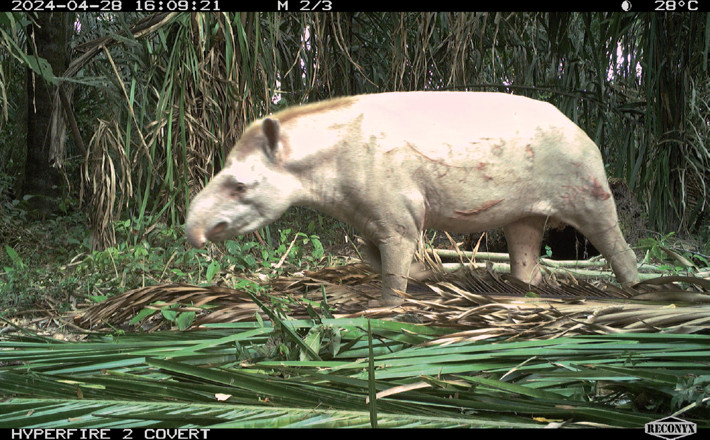Primer registro de leucismo en un tapir de tierras bajas silvestre Tapirus terrestris (Linnaeus, 1758) en la región de la Orinoquia colombiana
DOI:
https://doi.org/10.31687/SaremNMS25.1156Palabras clave:
anomalías, conservación, fragmentación, genética, polimorfismoResumen
Los fenotipos polimórficos, como el leucismo, ocurren como consecuencia de mutaciones genéticas y son raros en poblaciones silvestres. El leucismo, caracterizado por la pérdida parcial o completa de pigmentación, pero con un color de ojos normal, a menudo se asocia con la deriva genética y la endogamia en hábitats fragmentados. Reportamos el primer caso de leucismo en una danta o tapir de tierras bajas (Tapirus terrestris) silvestre en Arauca, Colombia. La fragmentación del hábitat debido a la expansión agrícola podría estar provocando aislamiento reproductivo y una disminución de la variabilidad genética. Este hallazgo subraya los posibles riesgos genéticos que enfrentan las poblaciones del tapir de tierras bajas y la importancia de realizar estudios genéticos y esfuerzos de conservación para mitigar estos riesgos en paisajes fragmentados.
Citas
Alviz, A., P. González-González, & J. Pérez–Torres. 2023. Scientific and traditional knowledge meet: diet of the lowland tapir Tapirus terrestris in the Orinoquia region of Colombia. Animal Biodiversity and Conservation 46:87–97. https://doi.org/10.32800/abc.2023.46.0087.
Aximoff, I., et al. 2020. Anomalous pigmentation in invasive and native marmosets, Callithrix jacchus, Callithrix penicillata (Primates, Callithrichidae), and their hybrids in Brazil. Folia Primatologica 91:149–158. https://doi.org/10.1159/000501186.
Cotts, L., J. P. Slifkin, R. Moratelli, L. Gonçalves, & O. Rocha-Barbosa. 2023. Multiple colors in anteaters: review and description of chromatic disorders in Tamandua (Xenarthra: Pilosa) with reports of new and rare coat colorations. Zoologia 40:e22034. https://doi.org/10.1590/S1984-4689.v40.e22034.
Derlindati, E. J., M. Cuevas Amorelli, S. D'Ingianti, & C. E. Trucco. 2013. First leucistic guanaco (Lama guanicoe) in the Andes mountains of northwestern Argentina: with comments on long-term conservation implications. Southwestern Naturalist 58:109–111. https://doi.org/10.1894/0038-4909-58.1.109.
Dias, M. M., A. L. P. Andrade, L. G. da Silva, & C. Rosa. 2023. First record of leucism in a crab-eating fox (Cerdocyon thous) from the Atlantic Forest hotspot. Brazilian Journal of Mammalogy 91:e91202279. https://doi.org/10.32673/bjm.vi91.79.
Ferreguetti, Á. C., W. M. Tomas, & H. G. Bergallo. 2017. Density, occupancy, and detectability of lowland tapirs, Tapirus terrestris, in Vale Natural Reserve, southeastern Brazil. Journal of Mammalogy 98:114–123. https://doi.org/10.1093/jmammal/gyw118.
García, M. J., E. P. Medici, E. J. Naranjo, W. Novarino, & R. S. Leonardo. 2012. Distribution, habitat and adaptability of the genus Tapirus. Integrative Zoology 7:346–355.
Guastalla, M. G., et al. 2021. The mysterious white deer: anomalous coloring in different Neotropical deer. Mammalian Biology 101:665–673. https://doi.org/10.1007/s42991-021-00156-9.
Kingsley, E. P., M. Manceau, C. D. Wiley, & H. E. Hoekstra. 2009. Melanism in Peromyscus is caused by independent mutations in Agouti. PLoS ONE 4:e6435. https://doi.org/10.1371/journal.pone.0006435.
Lucati, F. & López-Baucells, A. 2017. Chromatic disorders in bats: a review of pigmentation anomalies and the misuse of terms to describe them. Mammal Review 47(2):112–123.
Mejía-Valenzuela, E. G., & D. A. Auz-Cerón. 2020. Primer reporte de leucismo en Mazama murelia y Mazama zamora (Artiodactyla: Cervidae) en el corredor Cuyabeno-Yasuní, Ecuador. Notas Sobre Mamíferos Sudamericanos 1:e20.0.05. https://doi.org/10.31687/saremnms.20.0.05.
Nivelo-Villavicencio, C., & F. Rodas. 2021. Primer reporte de leucismo en Tapirus pinchaque (Perissodactyla, Tapiridae). Mammalia Aequatorialis 3:97–100. https://doi.org/10.59763/mam.aeq.v3i.30.
de Oliveira, M. B., M. A. Gentil, M. A. C. Cosentino, & C. R. Bonvicino. 2024. Review of chromatic disorder in the genus Artibeus (Chiroptera, Phyllostomidae), with new data for A. lituratus (Olfers, 1818). Notas Sobre Mamíferos Sudamericanos 6:e24.01.4. https://doi.org/10.31687/SaremNMS24.01.4.
Padilla, M., & R. C. Dowler. 1994. Tapirus terrestris. American Society of Mammalogists 481:1–8.
Pereira, J. A., L. I. Wolfenson, D. F. Artero, E. C. Argerich, D. Varela, & N. G. Fracassi. 2023. First records of pigmentation anomalies in the marsh deer at its southernmost stronghold: a warning message? European Journal of Wildlife Research 69:59. https://doi.org/10.1007/s10344-023-01694-y.
Pontes, A. R. M., A. P. Da Silva, & D. Chivers. 2020. The occurrence of leucism in groups of tayras Eira barbara Linnaeus 1758 on the Guyana Shield. Ecoscience 27:295–301. https://doi.org/10.1080/11956860.2020.1804724.
Ramos-Luna, J., M. F. Alvarez-Velazquez, C. A. Chapman, & J. C. Serio-Silva. 2022. Anomalous pigmentation in American primates: review and first record of a leucistic black howler monkey in southeast Mexico. Folia Primatologica 93:87–95. https://doi.org/10.1163/14219980-20201104.
Rubio, A. V., & J. A. Simonetti. 2019. Partial and complete leucism in two Abrothrix species (Rodentia: Cricetidae) from central Chile. Mammalia 83:100–102. https://doi.org/10.1515/mammalia-2017-0173.
Sagar, V., et al. 2021. High frequency of an otherwise rare phenotype in a small and isolated tiger population. PNAS 118:e2025273118. https://doi.org/10.1073/pnas.2025273118.
Scrich, V. M., M. C. Pônzio, N. Pasqualotto, T. F. Rodrigues, R. M. Paolino, & A. G. Chiarello. 2019. Occurrence of tayras (Eira barbara Linnaeus, 1758) with anomalous coloration in Cerrado remnants in the state of São Paulo, Brazil. Biota Neotropica 19:e20180680.
da Silva, V. L., J. Cândido, J. N. Campanha, D. R. de Oliveira, C. Gheler-Costa, & F. H. Oda. 2019. A stranger in the family? On the social behavior of a leucistic collared peccary (Pecari tajacu) with pigmented conspecifics. Tropical Ecology 60:303–305. https://doi.org/10.1007/s42965-019-00036-x.
Summers, C. G. 2009. Albinism: classification, clinical characteristics, and recent findings. Optometry and Vision Science 86:659–662.
Tavares, M. S., L. D. S. Aguiar, C. H. Salvador, & M. Galliez. 2020. Beyond the color: the implications of pigmentation polymorphism in the activity behavior of a Neotropical squirrel. Mammalia 84:294–298. https://doi.org/10.1515/mammalia-2019-0025.
Tirira, D. G., & E. Arbeláez. 2020. Primer reporte de leucismo en un tapir amazónico (Perissodactyla, Tapiridae) nacido bajo cuidado humano. Mammalia Aequatorialis 2:85–88. https://doi.org/10.59763/mam.aeq.v2i.19.
Tobler, M. W., Janovec, J. P., & Cornejo, F. 2010. Frugivory and seed dispersal by the lowland tapir Tapirus terrestris in the Peruvian Amazon. Biotropica 42(2):215–222. https://doi.org/10.1111/j.1744-7429.2009.00549.x.
Varela, D., et al. 2019. Tapirus terrestris, lowland tapir. The IUCN Red List of Threatened Species 2019:e.T21474A45174127. https://doi.org/10.2305/IUCN.UK.2019-1.RLTS.T21474A45174127.en.
Viloria de la Hoz, J. 2009. Geografía económica de la Orinoquia. Banco de la República de Colombia. Cartagena de Indias, Colombia. <https://www.banrep.gov.co/es/geografia-economica-orinoquia>.
Zeiger, J. M., C. J. Proctor, & S. E. Inman. 2018. Observations of leucistic turkey vultures (Cathartes aura) in Jamaica. Journal of Caribbean Ornithology 30:128–133. https://doi.org/10.55431/jco.2017.30(2).128-133.

Descargas
Publicado
Cómo citar
Número
Sección
Licencia
Derechos de autor 2025 Ángela Alviz, Gina Quintero, Nidia Farfán-Ardila, Karen Pérez-Albarracín

Esta obra está bajo una licencia internacional Creative Commons Atribución-NoComercial 4.0.

